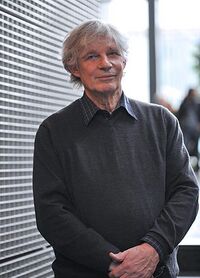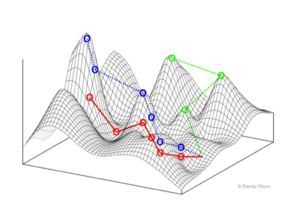“斯图尔特·艾伦·考夫曼 Stuart Alan Kauffman”的版本间的差异
(→外部链接) |
|||
| 第71行: | 第71行: | ||
<br> | <br> | ||
| − | == | + | == 适应度景观 == |
| − | [[File:Visualization_of_two_dimensions_of_a_NK_fitness_landscape.png|thumb| | + | [[File:Visualization_of_two_dimensions_of_a_NK_fitness_landscape.png|thumb|NK适应度景观的两个维度的可视化。箭头表示种群在适应度景观中进化时可能遵循的各种突变路径。]] |
2024年4月23日 (二) 20:07的最新版本
斯图尔特·艾伦·考夫曼 Stuart Alan Kauffman,于1939年9月28日出生,美国医学博士、理论生物学家和复杂系统研究员,主要研究地球上生命的起源。他是芝加哥大学、宾夕法尼亚大学和卡尔加里大学的教授。他目前是宾夕法尼亚大学生物化学荣誉退休教授和系统生物学研究所的附属教员。他获得过许多奖项,包括麦克阿瑟奖学金和维也纳奖章。
正如他在1993年出版的《秩序的起源 Origins of Order》一书中所讨论的那样,他最为人所知的观点是,生物系统和有机体的复杂性可能来自自组织和远离平衡的动力学,也可能来自达尔文的自然选择。1967年和1969年,他利用随机布尔网络研究基因调控网络的一般自组织特性,提出细胞类型是基因调控网络中的动态吸引子,细胞分化可以理解为吸引子之间的过渡。最近的证据表明,人类和其他生物体中的细胞类型是吸引物。1971年,他提出受精卵在发育过程中可能无法接触到其基因调控网络中所有的细胞类型吸引子,一些发育中无法接触到的细胞类型可能是癌细胞类型。这暗示了“癌症分化治疗”的可能性。他还提出了聚合物集体自催化集的自组织出现,特别是多肽,作为分子繁殖的起源,这已经得到了实验支持。
教育和早期职业
1960年考夫曼毕业于达特茅斯大学,1963年被牛津大学授予荣誉文学士学位(马歇尔奖学金),1968年在加州大学旧金山分校获得医学学位(医学博士)。完成实习之后,他搬进了果蝇的发育遗传学,持有任命第一芝加哥大学从1969年到1973年,美国国家癌症研究所从1973年到1975年,然后在宾夕法尼亚大学从1975年到1994年,他在那里的生物化学和生物物理学教授。
职业生涯
考夫曼之所以为人所知,是因为他与圣塔菲研究所(一个致力于研究复杂系统的非营利研究机构)的合作,他在1986年至1997年期间担任该研究所的常驻教员,以及他在生物学各个领域的模型研究工作。这些包括生命起源研究中的自催化集,发育生物学中的基因调控网络,以及进化生物学中的健康景观。与Marc Ballivet合作,考夫曼在组合化学和应用分子进化领域拥有广泛的生物技术专利,1987年在法国首次发布,[1]1989年在英国发布,后来在北美发布。[2]
1996年,考夫曼与安永会计师事务所 Ernst and Young合作,成立了位于新墨西哥州圣达菲的营利性公司BiosGroup,该公司将复杂的系统方法应用于商业问题。BiosGroup于2003年初被NuTech Solutions收购。NuTech在2008年被Netezza收购,后来又被IBM收购。[3][4][5]
从2005年到2009年,考夫曼在卡尔加里大学担任生物科学、物理学和天文学的联合职位。他也是卡尔加里大学哲学系的兼职教授。他曾担任iCORE(信息学卓越研究圈)主席和生物复杂性和信息学研究所所长。考夫曼还被邀请帮助在哈佛神学院发起科学与宗教倡议,并于2009年担任客座教授。
2009年1月考夫曼成为坦佩雷科技大学信号处理系芬兰特聘教授(FiDiPro),该任命于2012年12月结束。FiDiPro研究项目的主题是基于单分子水平的基因表达数据开发基因调控网络的延迟随机模型。
2010年1月考夫曼加入佛蒙特大学,在那里他继续在佛蒙特大学的复杂系统中心工作了两年。[6]从2011年初到2013年4月,考夫曼定期为NPR博客13.7“Cosmos and Culture”撰稿,[7]主题涵盖生命科学、系统生物学、医学、灵性、经济学和法律。[7] 他也是Edge.org的定期撰稿人。[8]
2013年5月,他加入了位于华盛顿州西雅图的系统生物学研究所。在他的妻子去世后,考夫曼与人共同创办了转化医学:伊丽莎白考夫曼研究所。
2014年,考夫曼与萨穆里·尼拉宁 Samuli Niiranen和嘉宝·瓦泰 Gabor Vattay获得了一项关于“平衡状态”[9](realm,见下文)的创始专利,这是一种显然是新的“物质状态”,在量子领域和经典领域之间可逆地徘徊。
2015年,他应邀发起了一场关于重新思考联合国经济增长的一般性讨论。[10]大约在同一时间,他与牛津大学教授Teppo Felin进行了合作研究。[11]
适应度景观
考夫曼的NK模型定义了一个组合相空间,由长度为[math]\displaystyle{ N }[/math]的每个字符串(从给定的字母表中选择)组成。对于这个搜索空间中的每个字符串,定义了一个标量值(称为适应度)。如果在字符串之间定义了距离度量,那么得到的结构就是一个地形。
适应度值是根据模型的具体具体化来定义的,但NK模型的关键特征是给定字符串[math]\displaystyle{ S }[/math]的适应度是字符串中每个轨迹[math]\displaystyle{ S_i }[/math]的贡献之和:
- F(S) = \sum_i f(S_i),
一般来说,每个基因座的贡献取决于[math]\displaystyle{ K }[/math]个其他基因座的值:
- [math]\displaystyle{ f(S_i) = f(S_i, S^i_1, \dots, S^i_K), \, }[/math]
其中[math]\displaystyle{ S^i_j }[/math]是[math]\displaystyle{ S_i }[/math]适合度所依赖的其他位点。
因此,适应度函数[math]\displaystyle{ f(S_i, S^i_1, \dots, S^i_K) }[/math]是长度为K + 1的字符串和标量之间的映射,温伯格 Weinberger后来的工作称之为“适应度贡献”。这样的适应度贡献通常是从某些特定的概率分布中随机选择的。
1991年,温伯格发表了一篇详细的案例分析,[12]其中[math]\displaystyle{ 1 \lt \lt k \le N }[/math]和适应度贡献是随机选择的。他对局部最优解数目的分析估计后来被证明是有缺陷的。然而,Weinberger的分析中包含的数值实验支持了他的分析结果,即弦的期望适合度是正态分布的,其平均值和方差都是近似的。平均值约为[math]\displaystyle{ \mu + \sigma \sqrt{{2 \ln (k+1)} \over {k+1}} }[/math] ,方差约为[math]\displaystyle{ {{(k+1)\sigma^2} \over {N[k+1 + 2(k+2)\ln(k+1)]}} }[/math]。
表彰与奖项
考夫曼在1987年至1992年期间举办了麦克阿瑟奖学金。他还获得卢万大学科学荣誉学位(1997年);他在1973年获得了诺伯特·维也纳控制论纪念奖金奖,1990年获得了罗马意大利猞猁之眼国家科学院(dei Lincei)金奖,2001年获得了特罗(Trotter)信息和复杂性奖,2013年获得了赫伯特 · 西蒙(Herbert Simon)复杂系统奖。他于2009年成为加拿大皇家学会会员。
工作
考夫曼最著名的论点是,生物系统和有机体的复杂性可能来自自组织和远离平衡的动力学,也可能来自达尔文的自然选择,在进化生物学的三个领域,即种群动力学、分子进化和形态发生。在分子生物学方面,考夫曼的结构主义方法因忽视了能量在驱动细胞生化反应中的作用而受到批评,这种作用可以被称为自催化,但不是简单的自组织。[13]一些在考夫曼领域工作的生物学家和物理学家对他关于自组织和进化的观点提出了质疑。一个恰当的例子是2001年出版的《生物系统中的自组织 Self-Organization in Biological Systems》一书中的一些评论。[14]Roger Sansom在2011年出版的《天才基因:基因调控网络如何进化到控制发展 Ingenious Genes: How Gene Regulation Networks Evolve to Control Development》一书,是对考夫曼关于基因调控网络的自组织模型的扩展批评。[15]
考夫曼借鉴物理学中的自旋玻璃模型,发明了“N-K”适应性地形,并在生物学和经济学中得到了应用。在相关的工作中,考夫曼和他的同事研究了经济系统中的次批判、批判和超实践行为。
考夫曼的工作将他的生物学发现转化为身心问题和神经科学问题,提出了一个无限期徘徊在量子一致性和古典主义之间的新“平衡领域”的属性。他在他的论文《回答笛卡尔:超越图灵 Answering Descartes: beyond Turing》中发表了这一主题。与Giuseppe Longo和Maël Montévil,他写道(2012年1月)《生物圈进化中没有必然规律,但存在使能关系 No Entailing Laws, But Enablement in the Evolution of the Biosphere》,认为进化不像物理学那样是“必然规律”。
考夫曼的作品发表在Physics ArXiv上,包括《超越僵局:身心、量子力学、自由意志、可能的泛心主义、量子谜的可能解决方案 Beyond the Stalemate: Mind/Body, Quantum Mechanics, Free Will, Possible Panpsychism, Possible Solution to the Quantum Enigma》(2014年10月)和《生命起源的量子临界性 Quantum Criticality at the Origin of Life》(2015年2月)。
考夫曼通过引入相邻可能的数学,为累积技术进化这一新兴领域做出了贡献。[16][17]
他发表了350多篇文章和6本书:《秩序的起源 The Origins of Order》(1993年)、《在宇宙中安家 At Home in the Universe》(1995年)、《调查 Investigations》(2000年)、《重新创造神圣 Reinventing the Sacred》(2008年)、《创造性宇宙中的人类 Humanity in a Creative Universe》(2016年)和《超越物理学的世界 A World Beyond Physics》(2019年)。
2016年,考夫曼写了一篇儿童故事《帕特里克、鲁伯特、斯莱和格斯的原始细胞》,讲述了生物圈中难以描述的生态位创造,后来被制作成动画短片。[18]
2017年,考夫曼与露丝·卡斯特纳 Ruth Kastner和迈克尔·艾伯森 Michael Epperson合著了《认真对待海森堡的潜能 Taking Heisenberg's Potentia Seriously》,探讨了现实既包括本体论上真实的“可能性”,也包括本体论上真实的“实际”这一概念。[19]
出版物
所选文章
- Kauffman, S. A.; McCulloch, W. S. (1967). "Random Nets of Formal Genes. Quarterly Progress Report 34". Research Laboratory of Electronics, Massachusetts Institute of Technology.
{{cite journal}}: Cite journal requires|journal=(help) - Kauffman, Stuart (1969). "Metabolic stability and epigenesis in randomly constructed genetic nets". Journal of Theoretical Biology. 22 (3): 437–467. doi:10.1016/0022-5193(69)90015-0. PMID 5803332.
- Kauffman, S. A. (1971a). "Cellular Homeostasis, Epigenesis, and Replication in Randomly Aggregated Macromolecular Systems". Journal of Cybernetics. 1: 71–96. doi:10.1080/01969727108545830.
- Kauffman, S. A. (1971b). "Differentiation of Malignant to Benign Cells". Journal of Theoretical Biology. 31 (3): 429–451. doi:10.1016/0022-5193(71)90020-8. PMID 5556142.
- Kauffman, Stuart (August 1991). "Antichaos and Adaptation" (PDF). Scientific American. 265 (2): 78–84. Bibcode:1991SciAm.265b..78K. doi:10.1038/scientificamerican0891-78. PMID 1862333. Retrieved 2015-04-28.
- Kauffman, S. A.; Johnsen, S (1991). "Co-Evolution to the Edge of Chaos: Coupled Fitness Landscapes, Poised States, and Co-Evolutionary Avalanches" (PDF). Journal of Theoretical Biology. 149 (4): 467–505. CiteSeerX 10.1.1.502.3299. doi:10.1016/s0022-5193(05)80094-3. PMID 2062105.
- Kauffman, Stuart (2004). "Autonomous Agents". Science and Ultimate Reality: Quantum Theory, Cosmology, and Complexity. Cambridge University Press. ISBN 978-0521831130.
- Kauffman, Stuart (2004). "Prolegomenon to a General Biology". Debating Design: From Darwin to DNA. Cambridge University Press. ISBN 978-1139459617.
- Kauffman, Stuart A. (November 12, 2006). "Beyond reductionism: Reinventing The Sacred". Edge.com. Edge Foundation. Retrieved 2015-04-28.
- Hanel, R.; Kauffman, S. A.; Thurner, S. (2007). "Towards a Physics of Evolution: Critical Diversity Dynamics at the Edges of Collapse and Bursts of Diversification". Physical Review E. 76 (3): 036110. Bibcode:2007PhRvE..76c6110H. doi:10.1103/physreve.76.036110. PMID 17930309.
- Kauffman, Stuart (May 7, 2008). "Why Humanity Needs a God of Creativity". New Scientist. 198 (2655): 52–53. doi:10.1016/s0262-4079(08)61171-9. Retrieved 2015-04-28.
- Nykter, M.; Price, N. D.; Aldana, M.; Ramsey, S. A.; Kauffman, S. A.; Hood, L.; Yli-Harja, O.; Shmulevich, I. (2008). "Gene Expression Dynamics in the Macrophage Exhibit Criticality". Proc Natl Acad Sci USA. 105 (6): 1897–1900. Bibcode:2008PNAS..105.1897N. doi:10.1073/pnas.0711525105. PMC 2538855. PMID 18250330.
- Huang, S.; Hu, L.; Kauffman, S.; Zhang, W.; Shmulevich, I. (2009). "Using cell fate attractors to uncover transcriptional regulation of HL60 neutrophil differentiation". BMC Systems Biology. 3: 20. doi:10.1186/1752-0509-3-20. PMC 2652435. PMID 19222862.
- Huang, S.; Kauffman, S. A. (2009). "Complex Gene Regulatory Networks - from Structure to Biological Observables: Cell Fate Determination". In Meyers, R. A.. Encyclopedia of Complexity and Systems Science. Springer. ISBN 978-0-387-75888-6.
- Kauffman, S. A. (2011). "Approaches to the Origin of Life on Earth". Life. Vol. 1, no. 1. pp. 34–48. doi:10.3390/life1010034. PMC 4187126. PMID 25382055.
- Longo, G.; Montévil, M.; Kauffman, S. (January 2012). "No entailing laws, but enablement in the evolution of the biosphere". arXiv:1201.2069 [q-bio.OT].
- Kauffman, Stuart; Hill, Colin; Hood, Leroy; Huang, Sui (2014b). "Transforming Medicine: A Manifesto". Scientific American Worldview. Archived from the original on July 13, 2014. Retrieved April 28, 2015.
- Kauffman, Stuart (October 2014). "Beyond the Stalemate: Conscious Mind-Body - Quantum Mechanics - Free Will - Possible Panpsychism - Possible Interpretation of Quantum Enigma". arXiv:1410.2127 [physics.hist-ph].
- Felin, T.; Kauffman, S.; Koppl, R.; Longo, G. (December 2014). "Economic Opportunity and Evolution: Beyond Landscapes and Bounded Rationality" (PDF). Strategic Entrepreneurship Journal. 8 (4): 269–282. doi:10.1002/sej.1184. SSRN 2197512.
- Vattay, G.; Salahub, D.; Csaibai, I.; Nassmi, A.; Kauffman, S. (February 2015). "Quantum Criticality at the Origin of Life". Journal of Physics: Conference Series. 626 (1): 012023. arXiv:1502.06880. Bibcode:2015JPhCS.626a2023V. doi:10.1088/1742-6596/626/1/012023.
- Kauffman, S. (2016). "Answering Descartes: Beyond Turing". The Once and Future Turing. Cambridge University Press.
- 书籍
- Kauffman, Stuart (1993). The Origins of Order: Self Organization and Selection in Evolution. Oxford University Press. ISBN 978-0-19-507951-7.
- Kauffman, Stuart (1995). At Home in the Universe: The Search for Laws of Self-Organization and Complexity. Oxford University Press. ISBN 978-0195111309.
- Kauffman, Stuart (2000). Investigations. Oxford University Press. ISBN 978-0199728947. https://archive.org/details/investigations00kauf.
- Kauffman, Stuart (2008). Reinventing the Sacred: A New View of Science, Reason, and Religion. Basic Books. ISBN 978-0-465-00300-6. https://archive.org/details/reinventingsacre00kauf_0.
- Kauffman, Stuart (2016). Humanity in a Creative Universe. Oxford University Press. ISBN 978-0-19-939045-8.
注释
- ↑ "Procédé d'obtention d'ADN, ARN, peptides, polypeptides ou protéines, par une technique de recombinaison d'ADN".
- ↑ "Procedure for obtaining DNA, RNA peptides, polypeptides, or proteins by recombinant DNA techniques".
- ↑ "NuTech Solutions to Acquire BiosGroup's Software Development Operations". BusinessWire. 20 February 2003. Retrieved 5 July 2015.
- ↑ "Netezza Corporation Acquires NuTech Solutions". BusinessWire. 15 May 2008. Retrieved 5 July 2015.
- ↑ "IBM to Acquire Netezza". IBM News Room. IBM. 20 September 2010. Retrieved 5 July 2015.
- ↑ "Stuart Kauffman, complex systems pioneer, to join UVM faculty". Vermontbiz.com. Vermont Business Magazine. September 30, 2009. Retrieved 2015-04-28.
- ↑ 7.0 7.1 "Stuart Kauffman". NPR.org. Retrieved 2015-04-28.
- ↑ "Stuart A. Kauffman". Edge.org. Edge Foundation. Retrieved 2015-04-28.
- ↑ "Uses of systems with degrees of freedom poised between fully quantum and fully classical states".
- ↑ "Rethinking Economic Growth". academicimpact.un.org. 11 May 2015. Retrieved 2020-05-26.
- ↑ Felin, Teppo; Kauffman, Stuart; Koppl, Roger; Longo, Giuseppe (2014). "Economic opportunity and evolution: Beyond landscapes and bounded rationality" (PDF). Strategic Entrepreneurship Journal. 8 (4): 269–282. doi:10.1002/sej.1184.
- ↑ Weinberger, Edward (November 15, 1991). "Local properties of Kauffman's N-k model: A tunably rugged energy landscape". Physical Review A. 10. 44 (10): 6399–6413. Bibcode:1991PhRvA..44.6399W. doi:10.1103/physreva.44.6399. PMID 9905770.
- ↑ Fox, Ronald F. (December 1993). "Review of Stuart Kauffman, The Origins of Order: Self-Organization and Selection in Evolution". Biophys. J. 65 (6): 2698–2699. Bibcode:1993BpJ....65.2698F. doi:10.1016/s0006-3495(93)81321-3. PMC 1226010.
- ↑ Camazine, Scott; Deneubourg, Jean-Louis; Franks, Nigel R.; Sneyd, James; Theraulaz, Guy; Bonabeau, Eric (2001). Self-Organization in Biological Systems. Princeton Studies in Complexity. Princeton, New Jersey: Princeton University Press. pp. 88–89, 283. doi:10.2307/j.ctvzxx9tx. ISBN 0691012113. JSTOR j.ctvzxx9tx. OCLC 44876868.
- ↑ Sansom, Roger (2011). Ingenious Genes: How Gene Regulation Networks Evolve To Control Development. Life and Mind: Philosophical Issues in Biology and Psychology. Cambridge, Massachusetts: MIT Press. doi:10.7551/mitpress/9780262195812.001.0001. ISBN 9780262195812. OCLC 694600461. 参见: Wray, Gregory A. (December 2012). "Adaptation and Gene Networks: Ingenious Genes: How Gene Regulation Networks Evolve to Control Development [book review]". BioScience. 62 (12): 1084–1085. doi:10.1525/bio.2012.62.12.10.
- ↑ Tria, F.; Loreto, V.; Servedio, V. D. P.; Strogatz, S. H. (July 2014). "The dynamics of correlated novelties". Scientific Reports. 4: 5890. arXiv:1310.1953. Bibcode:2014NatSR...4E5890T. doi:10.1038/srep05890. PMC 5376195. PMID 25080941.
- ↑ Monechi, Bernardo; Ruiz-Serrano, Álvaro; Tria, Francesca; Loreto, Vittorio (June 2017). "Waves of novelties in the expansion into the adjacent possible". PLoS ONE. 12 (6): e0179303. Bibcode:2017PLoSO..1279303M. doi:10.1371/journal.pone.0179303. PMC 5464662. PMID 28594909.
- ↑ 这个故事可以在这里阅读: "The Surprising True Story of Patrick S., Rupert R., Sly S., and Gus G. Protocells in Their Very Early Years" (PDF). 16 August 2016. Archived (PDF) from the original on 2020-05-27.
考夫曼在这里讲述了2017年的故事Ghostarchive and the Wayback Machine: "The Surprising True Story of Patrick, Rupert, Sly, and Gus". YouTube. 10 March 2017. Retrieved 2020-05-26.
这里有一个动画版本: Ghostarchive and the Wayback Machine: "The origins of life and its continuing wonder". YouTube. Science Animated. 24 August 2020.
斯图尔特·考夫曼通过讲述四种原始细胞——帕特里克、鲁伯特、希尔和格斯的故事,解释了生命是如何从37亿年前的早期起源进化而来的。他解释了为什么我们关于生命起源和早期进化的知识可以极大地帮助我们理解我们在世界上的真实位置。
- ↑ Kastner, Ruth E.; Kauffman, Stuart; Epperson, Michael (2019). "Taking Heisenberg's Potentia Seriously". Adventures in Quantumland: Exploring Our Unseen Reality. London ; Hackensack, NJ: World Scientific. pp. 223–237. arXiv:1709.03595. doi:10.1142/9781786346421_0011. ISBN 978-1-78634-641-4. OCLC 1083673555.
参考文献
- Chialvo, D. R. (2013). "Critical Brain Dynamics at Large Scale". Criticality in Neural Systems. 1. Wiley. ISBN 978-3-527-41104-7.
- Dadon, Z.; Wagner, N.; Ashkenasy, G. (2008). "The Road to Non-Enzymatic Molecular Networks". Angew. Chem. Int. Ed. 47 (33): 6128–6136. doi:10.1002/anie.200702552. PMID 18613152.
- Dadon, Z.; Wagner, N.; Cohen-Luria, R.; Ashkenasy, G. (2012). "Reaction Networks. Wagner and Askkenazy's (2008) results demonstrate that molecular replication need not be based on DNA or RNA template replication, still the dominate view for the origin of life". Supramolecular Chemistry: From Molecules to Nanomaterials. John Wiley and Sons, Ltd.. ISBN 978-0-470-74640-0.
- Rivkin, J. W.; Siggelkow, N. (May–June 2002). "Organizational Sticking Points on NK Landscapes". Complexity. 7 (5): 31–43. Bibcode:2002Cmplx...7e..31R. doi:10.1002/cplx.10037. Retrieved 2015-04-28.
进一步阅读
- Di Bernardo, Mirko (2011) (in it). I sentieri evolutivi della complessità biologica nell'opera di S. A. Kauffman. Milano: Mimesis. ISBN 978-8857504131.
- Goldstein, Jeffrey A. (2008). "Book Review of Reinventing the Sacred: A New View of Science, Reason, and Religion, by Stuart Kauffman". Emergence: Complexity & Organization. 10 (3): 117–130.
- Horgan, John (February 4, 2015). "Seeker Stuart Kauffman on Free Will, God, ESP and Other Mysteries". Scientific American. Retrieved 2015-04-28.
- MacKenzie, Dana (February 2002). "The Science of Surprise". Discover. 23 (2): 59–63.
- Rizzo, Francesco (2017). "Kauffman lettore di Wittgenstein" (in italiano). Palermo: Università degli studi di Palermo.
{{cite journal}}: Cite journal requires|journal=(help)
外部链接
- Paulson, Steve (November 9, 2008). "God Enough". Salon. Retrieved 2015-04-28.
- "Thinker of Untold Dreams: A Portrait of Stuart Kauffman". Vimeo.
- Archived at Ghostarchive and the Wayback Machine: "The Shape of History". YouTube. A talk at the New England Complex Systems Institute, January 28, 2019.
- 2019年1月28日,在新英格兰复杂系统研究所的一次演讲中,我们发现了一个叫做 Ghostarchive 和时光机的存档文件。
编辑推荐
集智课程
生命起源的最重要的问题——主体性与层级跃迁
生命作为最典型的复杂系统,从细胞到个体再到群体,在不同层次上都展现出各种复杂性,引发不同学科研究者的兴趣。为了促进生命复杂系统的跨学科交流,我们策划“生命复杂性”系列读书会,组织精读和讨论相关研究。生命起源是最迷人的科学问题之一,也是生物、化学、地质等多个学科的汇合地。而从复杂性科学的视角看,生命起源和发展是一个多次涌现、逐层跃迁的过程。
该课程中介绍了关于生命起源的四大经典理论和最新工作,并讨论生命分阶段起源的定量研究设想。
生命起源与自我复制
该课程介绍了生命起源与自我复制的概念以及其它们之间的关系。
本中文词条由范星辰翻译,薄荷编辑,如有问题,欢迎在讨论页面留言。
本词条内容源自wikipedia及公开资料,遵守 CC3.0协议。

